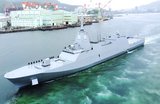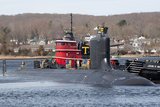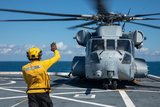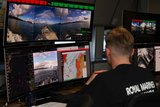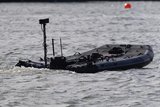LRASM MK 41 VLS testing successfully completed
A simulated Long Range Anti-Ship Missile (LRASM) has sucessfully undergone MK 41 Vertical Launch System (VLS) 'push-through' testing, Lockheed Martin reported on 3 June. The testing is part of the company's shipboard integration effort to prove LRASM can successfully function as an Offensive Anti-Surface Warfare (OASuW) weapon.
The four consecutive tests verified that the LRASM can break through the MK 41 canister's forward cover without causing damage to the composite structure, air data probe or coatings of the missile. This form of testing is an important risk reduction milestone in the programme to demonstrate the missile's surface launch capabilities.
LRASM is an autonomous, precision-guided anti-ship standoff missile being designed tomeet the needs of the US Navy and Air Force. The development of the missile builds on the successful Joint Air-to-Surface Standoff Missile Extended Range (JASSM-ER). The missile is in development by Lockheed Martin with the Defense Advanced Research Projects Agency (DARPA) and the Office of Naval Research.
LRASM cruises autonomously, day or night, in all weather conditions, armed with a proven penetrator and blast-fragmentation warhead. The missile employs a multi-modal sensor, weapon data link and an enhanced digital anti-jam Global Positioning System to detect and destroy specific targets within a group of ships. Both surface-launched and air-launched variants are planned to prosecute sea-based targets at significant standoff ranges.
Scott Callaway, LRASM surface launch program manager, Lockheed Martin Missiles and Fire Control, said: 'These test results verified that the LRASM vehicle can break through the VLS cover without damage at realistic flight speeds. Lockheed Martin is investing in the shipboard integration of LRASM and we are confident it will meet all the requirements for the US Navy.'
Later this year a Boosted Test Vehicle (BTV) version of LRASM will be launched from a MK 41 VLS platform, which will be followed by two government-funded Controlled Test Vehicle flights in 2014.
More from Naval Warfare
-
![UK to join US Navy’s Virginia-class submarine assembly effort to speed up construction]()
UK to join US Navy’s Virginia-class submarine assembly effort to speed up construction
The expansion of the Virginia-class submarine construction to UK shores could accelerate the project as US shipbuilders continue to fall short of delivery goals.
-
![US Navy seeks new sensors for the CH-53K King Stallion heavy-lift helicopter]()
US Navy seeks new sensors for the CH-53K King Stallion heavy-lift helicopter
The US Navy intends to publish a draft request for proposals in Q2 2026 and conduct an open competition for the supply of new electro-optical and infrared capabilities for the CH-53K heavy-lift helicopter.
-
![What new technologies could be involved in UK Atlantic Bastion initiative?]()
What new technologies could be involved in UK Atlantic Bastion initiative?
As new details emerge on the UK Royal Navy’s plan to secure the North Atlantic for the UK and NATO, three main areas of opportunity for new technology are the focal point.
-
![NATO naval exercises map out future USV requirements but raise questions on acquisition]()
NATO naval exercises map out future USV requirements but raise questions on acquisition
Uncrewed surface vessels have shifted from a desirable capability to a critical one for navies. But should these systems be bought outright, rented as a service or rapidly built using commercial off-the-shelf components?







